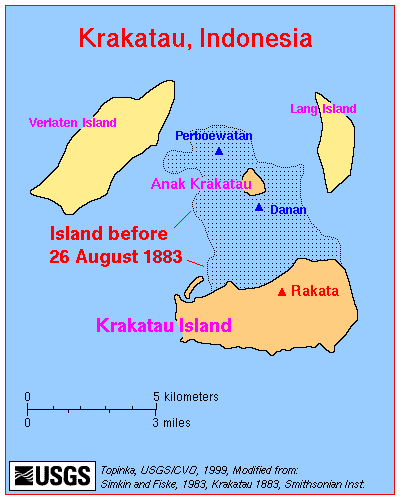
"A map of Krakatoa after the 1883 eruption,
showing the change in geography."
Posted on 11/28/2010 11:16:40 PM PST by Beowulf9
VIVAnews - Mt Anak Krakatau, a volcano located on the Sunda Strait between Sumatra and Java, Indonesia, has seen escalating expulsion of toxic gas. The volcanic activities were triggered by 5.5 magnitude tremor hitting southwest of Krui, Lampung, earlier in November. In addition, the sea temperature around the volcano has been rising as well.
According to Andi Arief, presidential advisor on Disaster Issues, revealed through a short message today, Nov 29, that the plumes of smoke sent off by the Anak Krakatau reached the height of between 200 and 800 meters into the air.
The data gathered was an accumulation of intense monitoring as of Sunday, Nov 28, at between 6.51 am and 4.35 pm.
"Nine volcanic earthquakes, 123 shallow volcanic earthquakes, 60 eruptive earthquakes and 63 eruptive tremors have been currently recorded," he said.
However, the government has yet to raise the alert level of the volcano, maintaining its status at level two.
NASA has listed Anak Krakatau as top volcanoes worldwide in need of strong monitoring.
Based on data of Geological Disaster Management and Volcanology Center of the Ministry of Energy and Mineral Resources, 19 out of 68 active volcanoes in Indonesia are now declared under the yellow level. The following are the listed mountains:


"In geology, subduction is the process that takes place at convergent boundaries by which one tectonic plate moves under another tectonic plate, sinking into the Earth's mantle, as the plates converge. A subduction zone is an area on Earth where two tectonic plates move towards one another and subduction occurs. Rates of subduction are typically measured in centimeters per year, with the average rate of convergence being approximately 2 to 8 centimeters per year (about the rate a fingernail grows).[1]
Subduction zones involve an oceanic plate sliding beneath either a continental plate or another oceanic plate (that is, the subducted plate is always oceanic while the subducting plate may or may not be oceanic). Subduction zones are often noted for their high rates of volcanism, earthquakes, and mountain building. This is because subduction processes result in melt of the mantle that produces a volcanic arc as relatively lighter rock is forcibly submerged."
Yes, I first heard of that on the documentary “Supervolcano”.
http://www.youtube.com/watch?v=bqpOTJAAwBU&feature=related
“Andi Arief, presidential advisor on Disaster Issues’
Obama: “So, Andi, what are your thoughts on the November election results?”
November *2008* occurred one of the worst geopolitical disasters in American history (aka “hope and change”).
This is fabulous. Sumatra is a hotbed, I expect it would never happen, but what if say 1/4 or 1/2 of these volcanoes erupted at once?
Great place to understand the mechanisms of volcanic activity.
Will study this earlier this afternoon, thanks for this information!
Beautiful photo! Looks at first to be a very romantic setting for a honeymoon-moonlight, stars, calm waters and a volcano glowing in the distance,and... HEY YOU BUM! STOP TAKING PICTURES AND LEAVE US ALONE!!!;)
Disclaimer: Opinions posted on Free Republic are those of the individual posters and do not necessarily represent the opinion of Free Republic or its management. All materials posted herein are protected by copyright law and the exemption for fair use of copyrighted works.